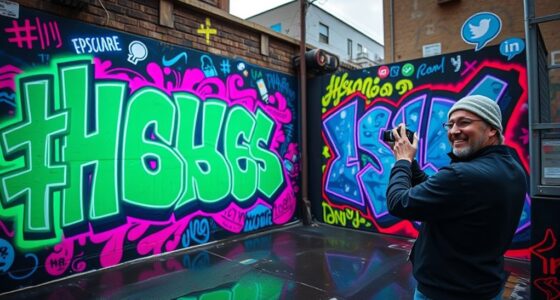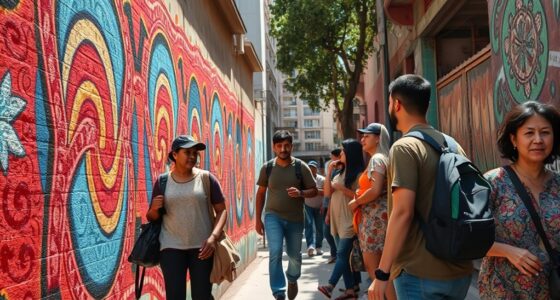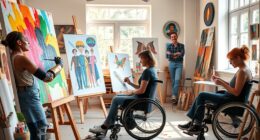Protest art has been a powerful way for you to see how people express dissent, from ancient carvings and revolutionary paintings to modern digital murals and social media campaigns. It’s evolved from traditional murals and symbols to include street art, videos, and virtual reality, reflecting ongoing struggles like civil rights, feminism, and climate change. If you keep exploring, you’ll discover how these visual expressions continue to influence society and inspire change today.
Key Takeaways
- Protest art has evolved from ancient symbols and revolutionary portraits to contemporary digital memes and virtual reality experiences.
- Historically, protest art shaped public perception through symbolic imagery, portraits, and political cartoons during key movements like revolutions and civil rights.
- Modern protest art leverages digital platforms and street art to reach global audiences instantly, facilitating real-time activism and community engagement.
- Artists have historically used diverse media such as collage, murals, and performance to challenge norms and highlight social injustices.
- The future of protest art emphasizes immersive technologies, inclusivity, and environmental themes, continuing its role as a powerful tool for social change.
Origins of Protest Art in Ancient Civilizations
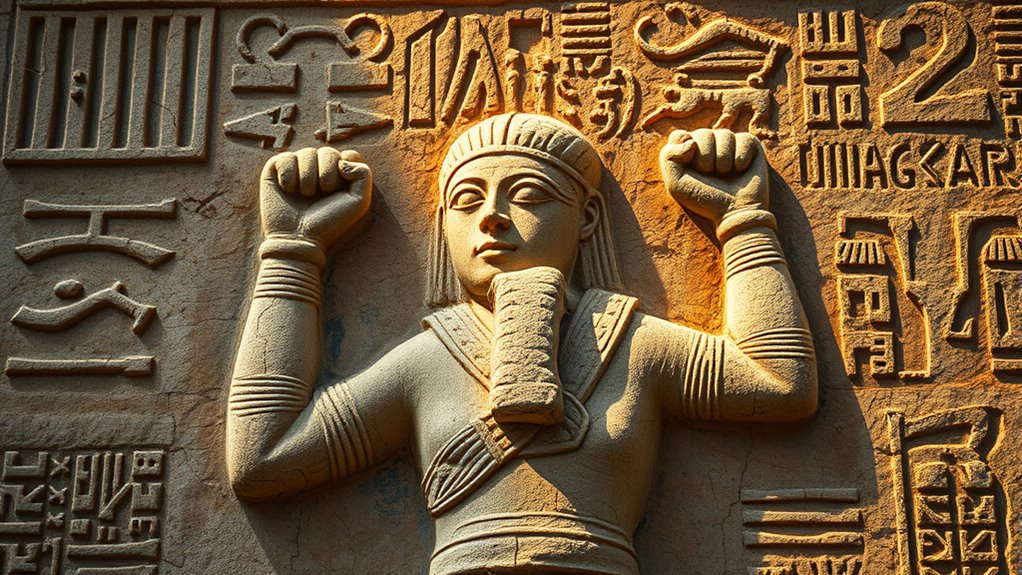
The origins of protest art in ancient civilizations reveal how early societies used visual expression to challenge authority and convey dissent. Art in places like ancient Egypt, especially during the 18th dynasty around 1350 BCE, shows the earliest examples of this. Akhenaten’s reign marks a turning point, as he introduced artwork that questioned traditional religious and political norms. When Tutankhamun came to power, he re-carved and repainted statues to erase Akhenaten’s influence, demonstrating how art became a tool for political conflict. Modern scans reveal layers of protest hidden beneath later artworks, showing that ancient artists often used carving, repainting, and re-purposing as subtle ways to communicate dissent. These efforts helped shape cultural memory and challenged authority through visual means. Religious motifs were frequently targeted as part of efforts to suppress or alter political messages embedded in art.
Revolutionary Uses of Art During the American and French Revolutions
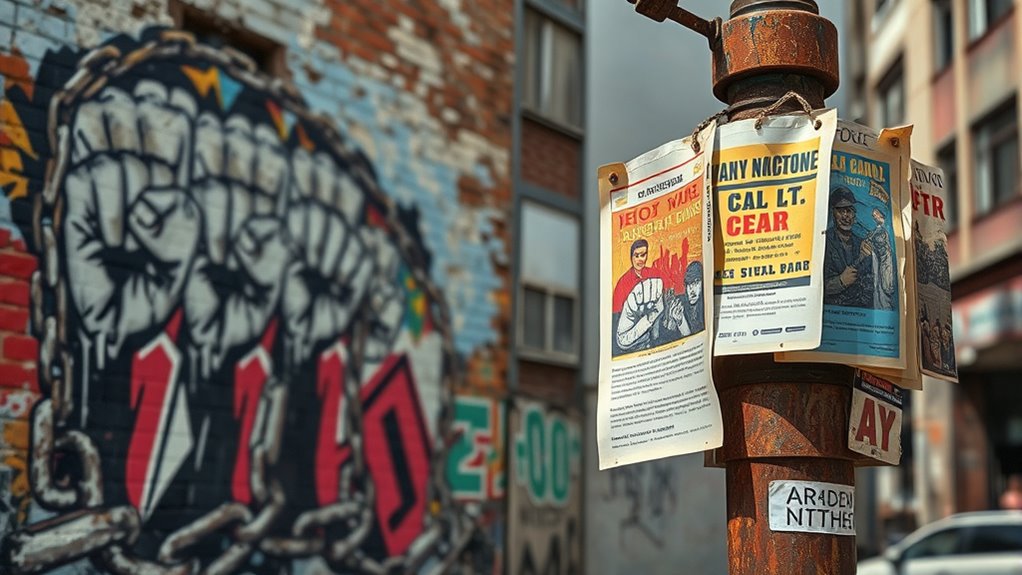
During the American and French Revolutions, artists played a pivotal role in shaping public perception and rallying support through powerful imagery. Portraits of leaders like Paul Revere and George Washington circulated to inspire loyalty and symbolize unity. Copley’s portraits included symbolic objects, subtly referencing resistance, while depictions of ordinary citizens fostered shared identity. Historical paintings memorialized key events, such as independence declarations and victories, reinforcing legitimacy and sacrifice. Political cartoons used animals and allegories to comment on alliances, factions, and political debates, influencing public opinion. French revolutionary art employed classical motifs and revolutionary symbols like the Phrygian cap to inspire unity and depict mass action. These visual strategies created lasting images that communicated ideals and mobilized support for revolutionary causes. Additionally, revolutionary artists often utilized visual propaganda to effectively communicate complex political messages and galvanize collective action among diverse audiences. The use of electricity production from bike generators exemplifies how modern visual and technological innovations can serve as tools for activism and social change. Furthermore, understanding the influence of currency fluctuations on revolutionary financing and propaganda efforts highlights the importance of economic factors in sustaining revolutionary movements.
Art Movements Supporting Women’s Rights and Civil Rights
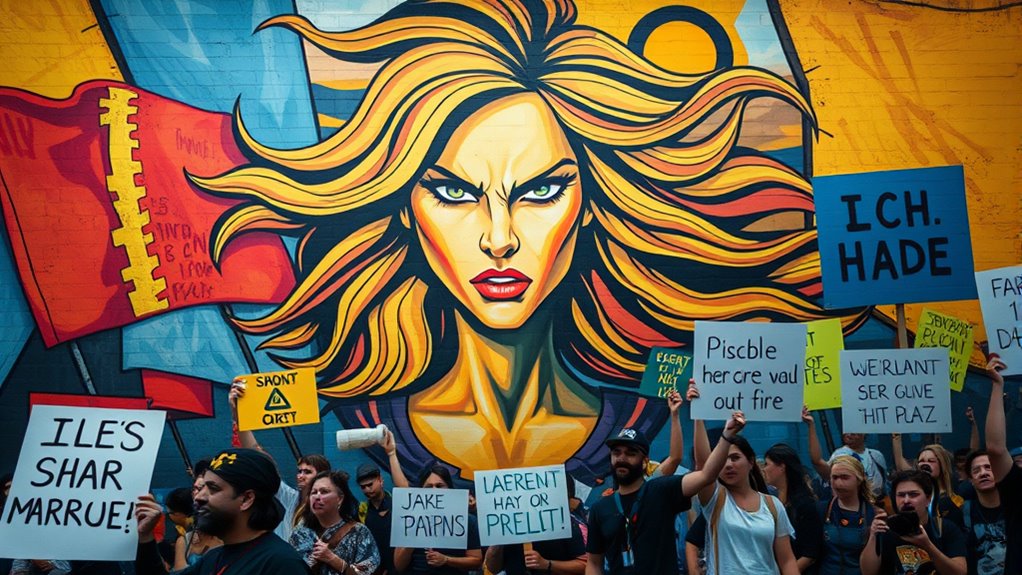
Art movements supporting women’s rights and civil rights have markedly reshaped how society perceives and addresses inequality. You’re part of a history where artists challenged sexist norms and demanded representation, especially during the late 1960s and early 1970s. These movements, rooted in civil rights, anti-war, and queer activism, used diverse media like performance, video, textiles, and installations to make powerful statements. You see how groups like the Guerrilla Girls used provocative posters and anonymity to expose sexism in galleries, while activists demanded equal museum representation. This activism pushed for dialogue on gender, sexuality, and the female experience, inspiring global networks. Their legacy continues, shaping art’s role in social justice and encouraging new generations to confront ongoing inequalities. International contributions like Hannah Höch from Germany and Frida Kahlo from Mexico further expanded feminist art’s reach and influence across different cultural contexts.
Vietnam War Era: Art as a Tool for Anti-War Sentiment

During the Vietnam War, visual campaigns and protest performance art became powerful tools to express anti-war sentiments. You see posters, murals, and street theater mobilizing communities and challenging government narratives. These creative acts helped turn individual voices into a collective movement for peace.
Visual Anti-War Campaigns
Visual anti-war campaigns during the Vietnam War harnessed powerful imagery and bold slogans to capture public attention and challenge government narratives. You see posters featuring striking graphic design, combining photomontage, hand-drawn elements, and provocative text to convey messages of resistance. Artists and collectives focused on civilian suffering, soldier experiences, and critiques of military policies, using imagery like doves, broken rifles, and burning draft cards to symbolize peace and defiance. These posters, displayed at rallies, demonstrations, and public spaces, spread through printmaking workshops and underground newspapers. Slogans like “Make Love, Not War” and “Hell No, We Won’t Go” became rallying cries. This visual approach shifted public opinion, mobilized dissent, and created a legacy that influenced future protests and social movements. The use of graphic design and photomontage also drew inspiration from earlier revolutionary art, amplifying the impact of these visual messages.
Protest Performance Art
Protest performance art emerged as a powerful and immediate way for artists to challenge the Vietnam War. You would find artists like Martha Rosler using live actions to directly confront political issues, making their messages visceral and urgent. This form allowed for real-time engagement, breaking from traditional art’s passive nature. Many artists incorporated their bodies into the work, turning performance into a critique of war’s brutality and societal complacency. The era also saw conceptual art where ideas took precedence, often involving audience participation or provocative acts to highlight anti-war sentiments. Socially engaged performance art united communities and amplified dissent, blending activism with artistic expression. By doing so, these performances became crucial tools in shaping public opinion and fostering resistance during a tumultuous time. Additionally, the rise of offensive security methods in cybersecurity reflects how proactive measures can be employed to defend against digital threats, paralleling the confrontational spirit of protest art. Recognizing the importance of visual impact, many of these performances relied on striking imagery and symbolism to communicate their messages effectively. Furthermore, the use of unique characteristics in art created memorable and distinctive representations of dissent that resonated with audiences across different contexts. An understanding of Relationships – Personality Test can also shed light on the ways audiences connect emotionally with such provocative works, fostering greater engagement and discussion.
Civil Rights Movements and the Power of Visual Narratives
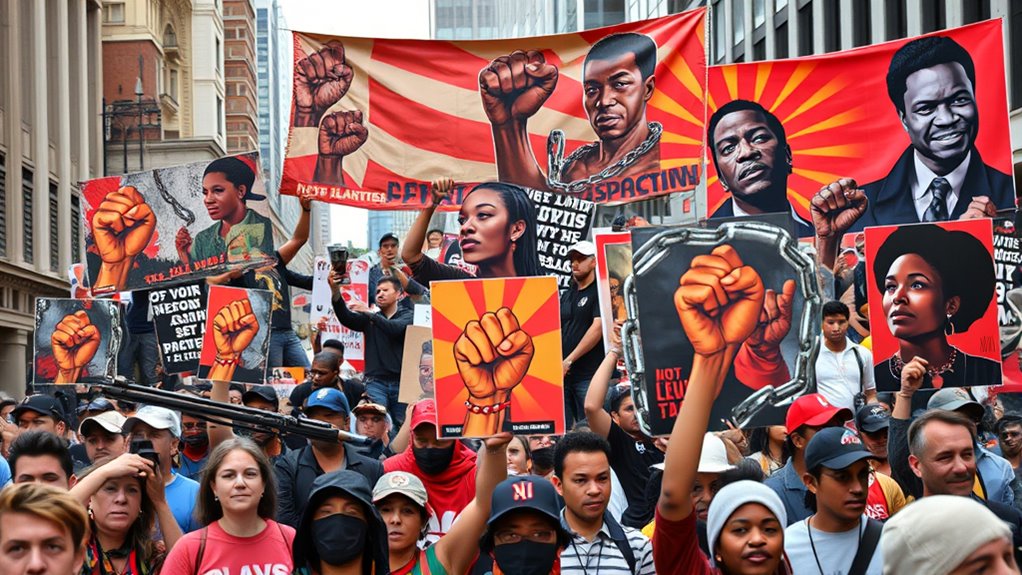
How do images shape our understanding of civil rights struggles? You see, powerful visual narratives capture moments of pain, hope, and resistance, making history tangible. Artists like Romare Bearden and Betye Saar used collage and assemblage to highlight racial issues and identity. Works inspired by events like the Montgomery Bus Boycott or Birmingham Riots, such as Charles White’s and Jack Whitten’s pieces, document these pivotal moments. These artworks raise awareness, inspire activism, and foster community dialogue. They serve as visual records, shaping public perception and influencing policy. Exhibitions like “Witness: Art and Civil Rights in the Sixties” showcase how art became a essential tool for social change. Through compelling imagery, you connect emotionally and intellectually to the ongoing fight for justice.
Contemporary Protest Art: Collective Actions and Digital Platforms
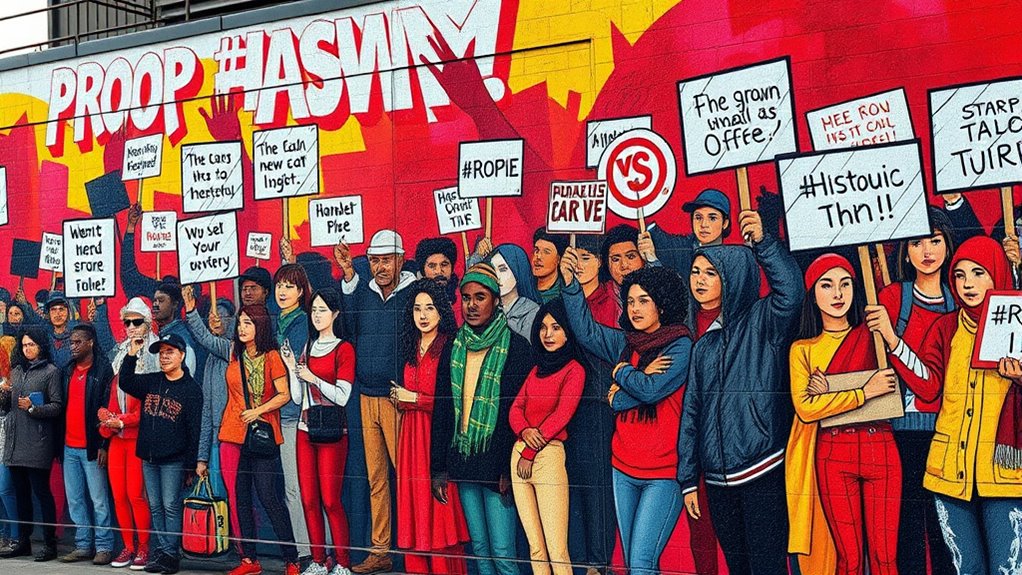
Digital platforms revolutionize protest art by enabling rapid sharing and broadening reach beyond local communities. You see artists collaborating in real-time and using memes or digital galleries to engage diverse audiences. These collective efforts amplify messages and create new avenues for activism in the digital age. Incorporating public engagement strategies can further strengthen the impact of protest art online. Utilizing digital tools can enhance the visibility and interactivity of protest artworks, fostering greater community participation and awareness. Additionally, leveraging predictive analytics can help organizers tailor campaigns to audience interests and measure engagement effectiveness. Understanding social media algorithms can also optimize the dissemination of protest messages and increase their reach. Awareness of credit card security measures is essential for protecting online platforms from cyber threats that could compromise sensitive data.
Digital Outreach Strategies
Contemporary protest art increasingly relies on digital platforms to amplify messages and mobilize supporters. Social media channels like Instagram, Twitter, and Facebook rapidly spread visual content—memes, infographics, and videos—that boost visibility and engagement. Hashtags such as #BlackLivesMatter and #MeToo enable global coordination, turning local protests into worldwide movements. Memes combine humor and critique, making activism approachable and easily shareable, often bypassing censorship through satire. Visual tools like infographics simplify complex issues, educating supporters and countering misinformation. Emerging technologies, including AR and VR, deepen engagement by transforming passive viewers into active participants. Additionally, digital activism has expanded the scope of protest art, allowing for innovative approaches to advocacy and awareness. The use of interactive media enhances emotional connection and personalizes the message, increasing the impact of digital protest campaigns. Incorporating mind-body awareness techniques can also help activists manage stress and online harassment, maintaining resilience in digital spaces. Furthermore, developing digital security skills is crucial for safeguarding activists’ identities and protecting their online presence. However, digital repression, censorship, and harassment pose challenges, requiring activists to adopt security tools and creative strategies to sustain their digital outreach efforts. Recognizing the importance of emotional support for activists facing online hostility can help maintain resilience and community strength in digital activism.
Collective Artistic Initiatives
Collective artistic initiatives play an essential role in modern protest movements by transforming public spaces into powerful platforms for shared messages. You see this in projects like Occupy Wall Street’s *Flowchart*, created by artist Rachel Schragis and activists, which spread widely to unify protesters’ grievances. Street art collectives produce large murals that visually communicate political messages, fostering community identity and solidarity. Quick-response graffiti projects respond to current events, making visual protests accessible to diverse audiences. Collaborative murals pool different artistic skills, amplifying protest narratives beyond individual efforts. These initiatives often involve local communities through participatory art, strengthening grassroots engagement. Additionally, groups like Artists for the Earth organize joint exhibitions and campaigns, connecting art with activism on environmental and social justice issues globally. Incorporating email marketing tools can further enhance the reach and impact of these collective efforts by facilitating coordinated digital campaigns and real-time sharing of visual content. Furthermore, leveraging visual storytelling techniques can deepen emotional connections and inspire broader participation in social movements. Recognizing the importance of public space as a canvas allows activists to utilize open areas effectively, increasing visibility and engagement. Emphasizing the role of digital platforms, these initiatives can extend their influence beyond physical locations, reaching a worldwide audience instantly. Engaging diverse audiences through social media amplifies the message and mobilizes support across different demographics.
Artistic Techniques and Media Employed in Protest Art

Protest art employs a diverse array of techniques and media to effectively communicate social and political messages. You’ll see symbolism used to convey complex ideas with simple images, inspiring action and community. Visual metaphors create powerful critiques of societal norms, while typography emphasizes key messages on posters and banners. Performance art involves artists’ bodies and actions, directly expressing dissent. Artists like Banksy use irony and vivid imagery to critique society creatively. Media ranges from traditional posters and street art to printmaking, photography, and digital platforms. Street art reclaims public spaces, while social media amplifies messages globally. Contemporary techniques include digital campaigns, collaborative projects, mixed media, performance, and anonymity, making protest art more dynamic and accessible than ever before.
The Enduring Influence and Cultural Significance of Protest Art
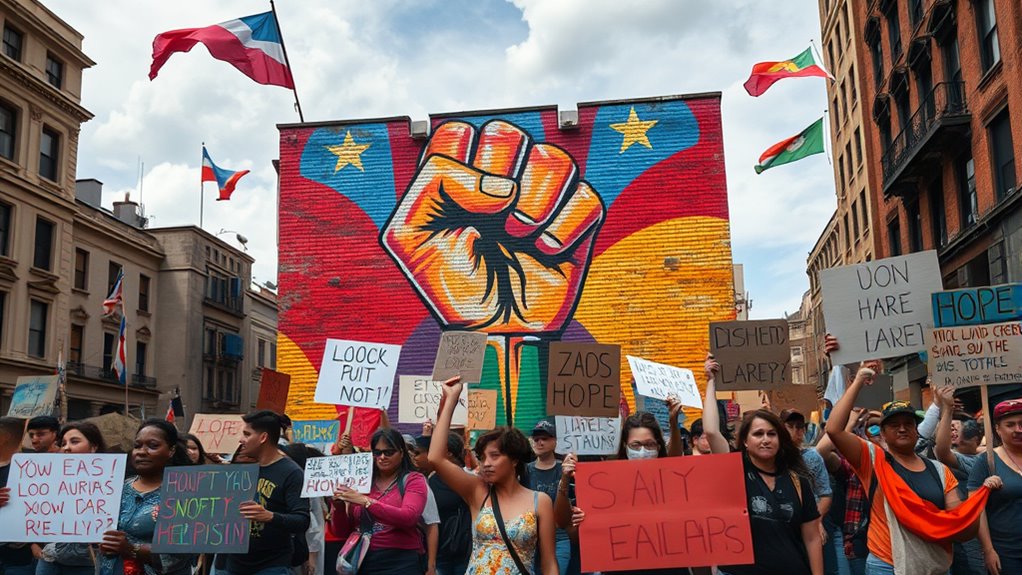
Throughout history, protest art has played a pivotal role in shaping social and cultural change by challenging norms and inspiring action. Its influence persists today, addressing issues like justice and equality. Protest art continues to evolve with new media and technology, reaching wider audiences and amplifying voices. Its cultural significance is evident in iconic works like *Guernica*, which symbolize resistance and shape narratives. Public space occupation remains a key tactic, transforming urban environments into platforms for dissent. The table below highlights core ideas about protest art’s lasting impact:
| Influence Type | Key Example | Effect |
|---|---|---|
| Cultural Legacy | *Guernica* | Shapes cultural narratives |
| Social Change | Civil rights protests | Sparks societal transformation |
| Global Reach | Modern digital activism | Extends protest influence worldwide |
The Global Impact and Future Directions of Visual Dissent
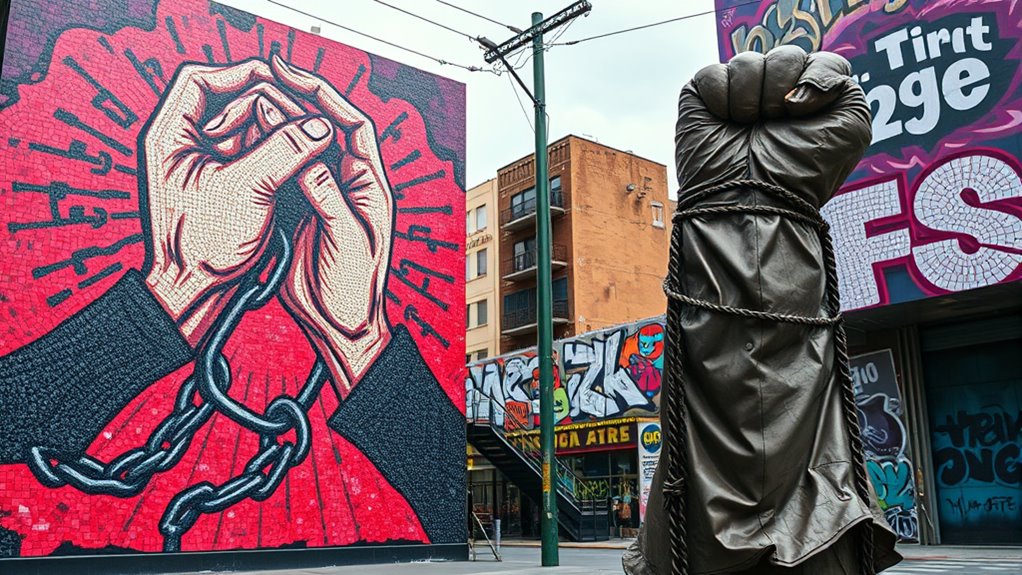
The global impact of visual dissent has grown considerably as artists and activists harness diverse mediums to challenge authority and spark social change. You see this evolution in how protest art now spans traditional paintings, street murals, digital media, and virtual reality, reaching broader audiences worldwide. Influenced by movements like abstract expressionism and pop art, protest art continues to reflect pressing issues like climate change and inequality, making it culturally relevant today. Looking ahead, technology will play a pivotal role, with AI and immersive platforms increasing engagement. Artists will focus more on environmental sustainability, personal stories, and amplifying underrepresented voices. Expect greater global collaboration among creators, transforming protest art into a powerful, interconnected tool for shaping social and political landscapes worldwide.
Frequently Asked Questions
How Has Protest Art Evolved With Digital Technology?
You see how digital technology has transformed protest art by making it more accessible, sophisticated, and immediate. You can now create powerful visuals using software like Photoshop or AI tools, with devices like tablets enhancing your creativity. Sharing your art across social media is instant, amplifying your message globally. This evolution allows you to engage communities, challenge norms, and inspire change more effectively than ever before.
What Are the Ethical Considerations in Creating Protest Art?
You’re about to commence on a journey of moral magnitude, where every brushstroke and pixel carries immense weight. When creating protest art, you must respect communities, avoid stereotypes, and amplify authentic voices. Think carefully about the potential impact—will it inspire change or deepen divides? Balance freedom of expression with ethical responsibility, ensuring your work uplifts marginalized groups and fosters genuine dialogue without manipulation or harm.
How Do Governments Typically Respond to Protest Art?
You should know that governments often react strongly to protest art by censoring or destroying it, passing laws to restrict its creation, and arresting artists who challenge their authority. They might also denounce it publicly or use propaganda to counter its message. These responses aim to suppress dissent, but they can also inspire increased activism, draw international attention, and strengthen cultural resilience among communities fighting for their rights.
Can Protest Art Be Effective Without Public Engagement?
You might think protest art works without public engagement, but in truth, it often loses power. Without interaction, it risks staying isolated, unable to inspire action or challenge dominant narratives. Public engagement transforms passive viewing into active dialogue, community building, and social change. When you involve people in creating or experiencing protest art, it becomes more relevant, impactful, and capable of mobilizing collective dissent.
What Role Does Social Media Play in Modern Protest Art Dissemination?
You see, social media plays a vital role in spreading protest art today. It allows you to share images, videos, and messages instantly with a global audience. Hashtags amplify your messages, making them go viral. You can organize protests, raise awareness, and build communities easily online. This digital platform helps your visual dissent reach more people, influencing opinions and encouraging action, all while bypassing traditional media gatekeepers.
Conclusion
You see, protest art persists as a powerful, passionate voice pushing boundaries and breaking barriers. It embodies boldness, bravery, and a boundless belief in change. By blending history with hope, it inspires action and ignites awareness. As you witness these works, remember they’re more than mere images—they’re incendiary impulses inspiring innovation, inspiring influence, and instigating impact. Keep kindling your compassion, because collective courage can conquer complacency and craft a culture of change.




